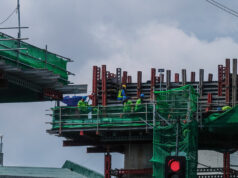Chen Yi launches rice processing facility
CHEN YI Agventures has launched its P1.7-billion rice processing complex for farmers in Alangalang, Leyte.
“We wanted to help rehabilitate the region. Basically, its top palay (unmilled rice) producing, but no post-harvest facilities. Ang dami-daming palay (There are so many unmilled rice), but no post-harvest facilities, and…typhoon Yolanda damaged the province, so the small rice mills that were existing, the small warehouses, were all wiped out, so we thought na sayang naman ’yung palay (unmilled rice can’t be wasted), and…instead of going to the Northern Luzon… the market there is already very matured, we decided to go where there is a lot of palay and we can build from the ground up, and at the same time help the community recover,” Chen Yi Agventures President Rachel Renucci-Tan told BusinessWorld in a phone interview.
The company was founded in 2015 by Ms. Tan and her husband Patrick Renucci, who were both professionals in their own fields prior to building the company.
“We will be the largest in Vis-Min Region and we committed to building the most technologically advanced rice processing complex in South East Asia,” she added.
The rice processing facility is situated in a two-hectare complex and uses temperature-controlled silos. Its phase one has a capacity of 6,000 metric tons (MT) of palay and can produce 25,000 metric tons (MT) of rice per year. The current structure can be expanded up to its second phase, doubling its production capacity, while the whole eight-hectare land area can house up to four phases.
The facility incorporates Japanese technology in the entire process. Everything is automated and is controlled via a control room.
“We are the only one in the Philippines, wherein its fully automated and has a control room… We don’t need operators…and that actually prevents errors from human interventions,” she said.
This also makes sure the quality of its rice, Renucci rice, is pest and contamination free through proper storage and processing of palay, she said. This eliminates the use of chemicals, which reduces the quality and nutrients of rice.
Its product has nutrients like that of brown rice, Ms. Tan said. “We use technology to process our rice, keeping all the nutrients.”
An optimal sorter is also used to segregate the whole grain white rice from broken grains, spotted grains, and the like.
Ms. Tan said this model should be replicated in other parts of the country in order to improve the country’s rice production process.
“This model is open for others to replicate, but can we roll out in other areas, yes why not. Let’s say the government supports us then…we are open to this process,” she said.
“We encourage them to do so so that the entire Philippines can produce world-class rice and hopefully one day we can rely less on imports,” she added.
Ms. Tan said expanding the facility will take time as this will be based on the demand for the rice it produces.
“We’re planning to expand once we’ve, basically when the demand outstrips supply and we need to produce more… It’s easy for us to expand because we’ve already built the structure for expansion,” she said. — Vincent Mariel P. Galang



